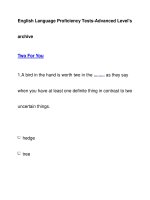Brainy Teenagers - Advanced Level Reading pps
Bạn đang xem bản rút gọn của tài liệu. Xem và tải ngay bản đầy đủ của tài liệu tại đây (111.29 KB, 5 trang )
Brainy Teenagers - Advanced Level Reading
Đây là bài
viết thú vị về chức năng hoạt động khác nhau giữa não thiếu niên và
người lớn. Đọc bài dưới đây và điền từ
Key words vào chỗ trống. Bạn có đồng ý
với bài
viết và nghĩ rằng thiếu niên khó có khả năng tập trung hơn người lớn
không? Hoặc chính bạn, cũng như tôi, nghĩ rằng có thể là do số lượng cà phê mà
chúng ta uống ngày càng nhiều khi chúng càng nhiều tuổi hơn!
Key Words
Monitored
Concentration
Research
Chaotic
Attention
Decreases
Distractions
Adolescents
Teenage Brains
Parents who despair over their teenagers' lack of
_1_ in class, inability to sit still
long enough to finish homework or plan ahead, should take solace. Their children
are not being lazy or careless – they are hapless victims of neurobiology.
New research has found that teenagers' brains continue developing far longer into
adulthood than previously thought.
_2_ may look like young adults but their brain
structure resembles that of much younger children, according to the study to be
published in the Journal of Neuroscience on Wednesday.
"It is not always easy for adolescents to pay_3_ in class without letting their minds
wander, or to ignore
_4_ from their younger sibling when trying to solve a maths
problem," said Dr Iroise Dumontheil of University College London's Institute of
Cognitive Neuroscience, one of the authors of the research. "But it's not the fault
of teenagers that they can't concentrate and are easily distracted. It's to do with the
structure of their brains. Adolescents simply don't have the same mental capacities
as an adult."
Using MRI scans, the brain activity of adolescents were
_5_ as they tried to solve
a problem in their heads while ignoring environmental distractions.
The scans revealed an unexpected level of activity in the prefrontal cortex, a large
region at the front of the brain involved in decision-making and multitasking. This
indicated that the brain was working less effectively than that of an adult.
"We knew that the prefrontal cortex of young children functioned in this
_6_ way
but we didn't realise it continued until the late 20s or early 30s," said Dr Sarah-
Jayne Blakemore, who led the study.
Chaotic thought patterns are a result, she said, of teenagers' brains containing too
much grey matter – the cell bodies and connections which carry messages within
the brain. As we age, the amount of grey matter in our brains
_7_
"What our_8_ has shown is that there is simply too much going on in the brains of
adolescents," said Blakemore. "The result is that their brain energy and resources
are wasted and their decision-making process negatively affected."
Adults, on the other hand, have less grey matter, said Blakemore. "This means that
neural transmissions travel more efficiently between brain cells, so the brain works
more effectively."
To read the full article visit />teenagers-cant-concentrate-brains
• Missing word 1:
• Missing word 2:
• Missing word 3
• Missing word 4:
• Missing word 5:
• Missing word 6:
• Missing word 7:
• Missing word 8:
Đáp án
1. concentration
2. adolescents
3. attention
4. distractions
5. monitored
6. chaotic
7. decreases
8. research









